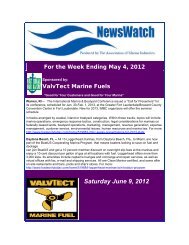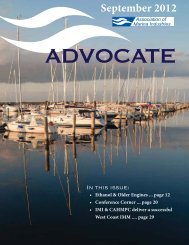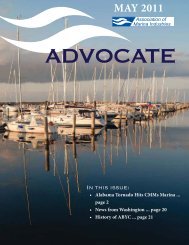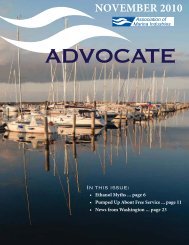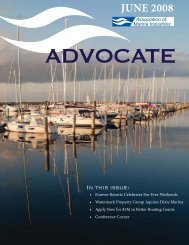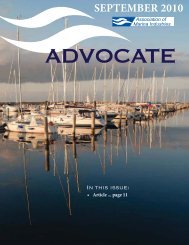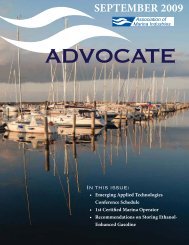Download a copy of AMI's Clean Marina best management practices ...
Download a copy of AMI's Clean Marina best management practices ...
Download a copy of AMI's Clean Marina best management practices ...
You also want an ePaper? Increase the reach of your titles
YUMPU automatically turns print PDFs into web optimized ePapers that Google loves.
Retention Basins: A retention basin is a stormwater facility that includes a permanent impoundment, or pool <strong>of</strong><br />
water, and therefore, is normally wet, even during dry periods. Inflows from stormwater run<strong>of</strong>f may be<br />
temporarily stored above this permanent pool.<br />
Extended Detention Basin: An extended-detention basin is an impoundment that temporarily stores run<strong>of</strong>f for<br />
a specified period and discharges it through a hydraulic outlet structure to a downstream conveyance system.<br />
An extended-detention basin is usually dry during non-rainfall periods. An Enhanced Extended Detention Basin<br />
includes a shallow marsh with emergent vegetation in the basin bottom, which increases the potential pollutant<br />
uptake.<br />
Constructed Stormwater Wetlands: Constructed stormwater wetlands are manmade shallow pools that create<br />
growing conditions suitable for both emergent and aquatic vegetation. Infiltration Practices: Infiltration facilities<br />
temporarily impound stormwater run<strong>of</strong>f and discharge it via infiltration into the surrounding soil. Infiltration<br />
facilities include Infiltration Basins, Infiltration Trenches, Ro<strong>of</strong> Downspout Systems, and Porous Pavement.<br />
Bioretention Practices: Bioretention Practices are shallow pockets or depressions underlain by an engineered<br />
soil mixture to facilitate filtration and exfiltration into the underlying natural soils. When the natural soil horizon<br />
below the facility is not suitable for infiltration, an under drain system is used to de-water the facility. Also referred<br />
to as rain gardens, bioretention <strong>practices</strong> include a landscaping plan <strong>of</strong> specific plant species which results<br />
in an aesthetic site feature, as well as a water quality BMP.<br />
Sand Filters: Intermittent sand filter facilities are underground vault-like facilities that capture, pre-treat, and<br />
filter the first flush <strong>of</strong> stormwater run<strong>of</strong>f. In some cases these facilities can include an above ground storage<br />
facility to store the excess volume <strong>of</strong> run<strong>of</strong>f from larger storms.<br />
Grassed Swale: A grassed swale is a broad and shallow earthen channel vegetated with erosion resistant and<br />
flood-tolerant grasses. Check dams are strategically placed in the swale to encourage ponding behind them. A<br />
Water Quality Swale is a broad and shallow earthen channel vegetated with erosion resistant and flood tolerant<br />
grasses, and underlain by an engineered soil mixture to facilitate filtration and exfiltration into the underlying<br />
natural soils. When the natural soil horizon below the swale is not suitable for infiltration, an under drain system<br />
is used to dewater the swale.<br />
Vegetated Filter Strip: A vegetated filter strip is a densely vegetated strip <strong>of</strong> land engineered to accept run<strong>of</strong>f<br />
from upstream development as overland sheet flow. It may adopt any naturally vegetated form, from grassy<br />
meadow to small forest. All stormwater <strong>management</strong> structures must be maintained to remain effective.<br />
Non-Structural BMP’s<br />
Nonstructural BMPs include any efforts to minimize the impact <strong>of</strong> the activities on, and the improvements to, the<br />
land surface on the aquatic environment<br />
• In most states a Stormwater Pollution Prevention Plan (SWPPP) must be written and updated and<br />
include the following requirements:<br />
- Used oil <strong>management</strong><br />
- Spent solvent <strong>management</strong><br />
- Proper disposal <strong>of</strong> spent abrasives<br />
- Disposal <strong>of</strong> vessel wastewater<br />
- Spill prevention and control<br />
- Safe fueling procedures<br />
- General good housekeeping<br />
- Appropriate painting and blasting procedures<br />
- Used battery <strong>management</strong><br />
A sample SWPPP is attached at the end <strong>of</strong> this document, Appendix A<br />
19



